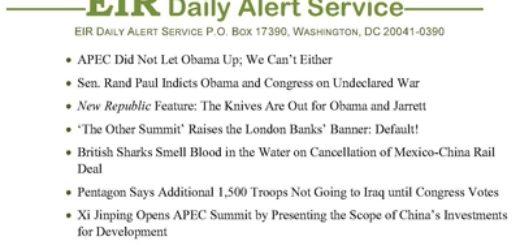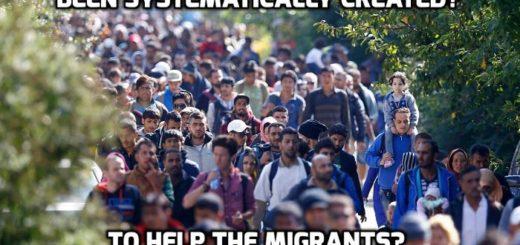EIR Daily Alert Service, TUESDAY, APRIL 30, 2019
| TUESDAY, APRIL 30, 2019 Volume 6, Number 84 EIR Daily Alert Service P.O. Box 17390, Washington, DC 20041-0390 |
What Lying Media Call Belt and Road ‘Critics’ Are Actually Strong Supporters
Prime Minister Conte Expresses Pride that Italy ‘Opened the Way’ to New Silk Road for Europe
Democratic Party Splitting between White House Meeting and ‘Watergate Hearing’
Journalist Solomon Presents Opportunity To Expose Anti-Trump Coup Plotters in Ukraine
Trump Demands Push for Arms Control Agreements with Russia and China
Trump’s GDP ‘Boom’ in First Quarter Significantly Owed to China
| Subscribe to EIR Daily Alert |
EDITORIAL
‘New Silk Road’ Is Unstoppable Dynamic; We Still Must Implement Lyndon LaRouche’s Economic Laws
April 29 (EIRNS)—Are more than 130 governments, 37 heads of state and government, all major international and financial institutions, and 5,000 businesses all at one conference, enough to convince that a new economic order is coming into being? The extraordinary attendance of governments, heads of state and government—a significant number of them recently considered “skeptics” and “critics” of Belt and Road infrastructure great projects—and companies at the Second Belt and Road Forum for International Cooperation, compared with the largest international meetings in history. It was already proof that the Belt and Road Initiative (BRI) has expanded greatly since the first Belt and Road Forum in 2017 and is now an unstoppable new paradigm of economy. Certain myths of “backfire” and “criticism” in Asia which have been spread, also fell away.
“Developments of the last period make very clear that the dominating dynamic in the world today is the Belt and Road Initiative,” stated Schiller Institute President Helga Zepp-LaRouche in a discussion with European colleagues today. She is, with her husband Lyndon LaRouche, an intellectual author of this dynamic from the 1980s onward. “This,” she said, “is the major initiative in terms of unprecedented infrastructure, in terms of a new set of relations, in terms of new cultural relations and a new spirit of the Silk Road, that it is simply the most powerful item on the agenda, and it’s the only long-term strategic plan to move the world into a new paradigm. And interestingly, this was stated more or less in that way by the Swiss President Ueli Maurer, who commented that this was Switzerland’s long-term strategic plan; then he signed a memorandum of understanding with Xi Jinping.” Italian Prime Minister Giuseppe Conte, who signed an MOU with President Xi in Rome last month, said essentially the same thing, happy that Italy had “opened the way for other European nations, who will now make agreements” with China’s New Silk Road.
The most urgent question, she said, is a cooperative relation between the United States and China. America, which was not represented at a high level at the Forum, needs the Belt and Road.
However, both need something else. “I think what is absolutely lacking is an unmediated access to the ideas of Lyndon LaRouche, of mostly the United States population, but well beyond that, of the whole world. And I have compared that to the impact that the introduction of Plato had in the context of the Councils of Ferrara and Florence, triggering the explosion of the Italian Renaissance. Because if Nicholas of Cusa would not have brought the Greek Orthodox Church scholars, Bessarion and Plethon, who all were the absolute scholars in Plato; and brought the entire works of Plato, which had been lost in Europe for 1,700 years—there were maybe a couple of copies in some monasteries, but nobody could read it any more, because people could not understand Greek any more—so, it was really when the Greek Orthodox Church brought Plato. Fortunately, you had the Medicis who financed a crash program to translate the works, and it was the excitement for Plato which made the Italian Renaissance what it became.
“And I think in the ferment of the Belt and Road Initiative, there are many good ideas and many important concepts, but the depth of what is required lies only in LaRouche’s works. So that is why the exoneration is so absolutely important, apart from the fact, that naturally, his opponents are the war party.”
Lyndon LaRouche’s exoneration, she concluded, “is the crucial piece in getting the world to a safe place.”
THE NEW GLOBAL ECONOMIC ORDER
What Lying Media Call Belt and Road ‘Critics’ Are Actually Strong Supporters
April 29 (EIRNS)—The extraordinary attendance of governments, heads of state and government, and thousands of businesses at the April 25-27 Second Belt and Road Forum for International Cooperation (BRF), comparing with the largest international meetings in history, was already proof that the Belt and Road Initiative has expanded greatly since the first BRF in May 2017 and is now an unstoppable new paradigm of economy. After the second BRF, certain myths of “backfire” and “criticism” in Asia also fell away.
Malaysian Prime Minister Mahathir Mohamed gave interviews in which he expressed full confidence in the BRI and surprise at its scope. Speaking to Malaysian media April 28, he said: “We feel that the [One Belt, One Road] OBOR initiative is not a domination plan by China, which would end up being controlled by China. Instead, it is a policy developed by all the countries, and not only focused on China….
“Previously there were other development plans by developed countries to create a world without borders and free trade, including the Trans-Pacific Partnership. They … made the proposals and asked us to accept them. This is not like that, the forum attendees are from small countries and they are sitting with China which has a 1.4 billion population. They sit together, at the same level, and talk about how to develop infrastructure projects.”
In an interview with China’s TV network CGTN, Dr. Mahathir said he had thought the Belt and Road was an infrastructure project for Asia. “But now it is quite clear that it is practically a worldwide project involving not only Southeast Asia and China, but also Middle East, Africa and even Latin America. It is an effort to improve connectivity all over the world…. I am very glad that I’m here because now I understand better the intention behind this idea of the BRI. … China has been able to develop a lot of new technologies and we need that technology.” He forecast large-scale Chinese investment and exports into Malaysia.
Indonesia’s Investment Minister, Harvard graduate Tom Lembong, who had been critical of China’s rail investments, told South China Morning Post that Indonesia has “found China’s openness to its feedback on improving the Belt and Road Initiative highly encouraging…. I believe in the next 5 to 10 years, BRI will stimulate additional investment in probably tens of billions of dollars” in Indonesia, Lembong said.
In Europe, Italy and Austria are joining Portugal in planning issuance of “Panda Bonds”—infrastructure bonds issued by other countries in yuan, to be issued into China’s bond market. Even Germany Economics Minister Peter Altmaier found the Belt and Road Forum “better than expected,” and is headed back with a newly created Mittelstand delegation, the BVDSI, devoted to Germany industry’s relation to the BRI.
Prime Minister Conte Expresses Pride that Italy ‘Opened the Way’ to New Silk Road for Europe
April 29 (EIRNS)—China’s President Xi Jinping and Italy’s Prime Minister Giuseppe Conte have described the relations between Italy and China as a model for the EU. Italy was the first European Union founding member and first G7 member nation to sign a memorandum of understanding with China, during Xi’s state visit in Rome last month. Conte reiterated his satisfaction with the April 25-27 Belt and Road Forum afterward, during a “tourist day” on April 28.
“As I said yesterday to President Xi, I hope I can come back soon. There are so many issues to be looked at in depth, several perspectives of development for new collaborations. I am convinced that out of this renewed partnership, both countries can draw mutual benefits at a parity of conditions.”
On April 27, Conte had met Russia’s President Vladimir Putin, Ethiopian Prime Minister Ahmed Abiy, IMF Managing Director Christine Lagarde, and Egyptian President Abdel Fattah el-Sisi.
“The series of bilateral meetings was concluded by the wonderful banquet offered by President Xi to me and to the entire Italian delegation that accompanied me,” he wrote in his Facebook account. “I am very satisfied by the strengthening of economic and trade relations between Italy and the People’s Republic and, personally, by the friendship which is being consolidated with President Xi Jinping. And I am proud that in the final release of the Belt and Road Forum, many of the Italian suggestions have been adopted, among them the references to financial and social sustainability, protection of human rights and of intellectual property.
“The Silk Road, I repeat, is a great opportunity for Italy, a challenge which we happily accepted through the signing of the MOU, in a framework of European principles and level playing field and with the maximum of guarantees for security of our strategic infrastructure. We have been a trailblazer for the other European partners which are now preparing to join this major infrastructural connectivity.”
U.S. POLITICAL AND ECONOMIC
Democratic Party Splitting between White House Meeting and ‘Watergate Hearing’
April 29 (EIRNS)—The Democratic Party’s split is evident as Congressional leaders Sen. Chuck Schumer and Reps. Nancy Pelosi and Ways and Means Chairman Richard Neal prepare for an April 30 White House meeting with President Donald Trump on infrastructure legislation, while a Congressional “impeach him” faction tries to order Attorney General William Barr into a “Watergate hearing” in the House Judiciary Committee.
Judiciary Chair Jerrold Nadler of New York is demanding that Barr agree to be questioned in the May 2 hearing by Committee lawyers for indefinite periods of time, followed by a closed session with Judiciary members. Barr may refuse to go to this “Watergate” proceeding unless the rules are changed.
Nadler and House Intelligence Chair Adam Schiff of California, along with a sizeable number of other Democratic leaders, clearly think attempting impeachment is the road to the White House in 2020, an idea of which the American public will disabuse them. Democrats holding town meetings during the just-ended Congressional recess admit they found impeachment not near the top of even Democratic voters’ agenda. Polls already show most Americans oppose it.
On the other hand, representatives from the AFL-CIO and U.S. Chamber of Commerce expressed optimism, in a conference call with media today, that Trump’s meeting with Schumer, Pelosi and Neal on infrastructure will produce some bipartisan results. Neil Bradley of the Chamber implied that his optimism was based on recent White House meetings. Both said, in answer to a question, that a national infrastructure bank should be part of the “tool kit” for such results. Also on the call was the American Trucking Association.
The overriding problem of the meeting—and of Pelosi’s side of the Democrat split—is the complete lack of an infrastructure mission, like the Moon-Mars mission and its Apollo Project predecessor under President John F. Kennedy, to be the driver for the work. Development of continent-wide new infrastructure with Canada and developing nations to the South, is another vital mission, also unthought of here. While the Congressional Republicans generally continue opposing Federal funding of infrastructure outright, these Democratic leaders are talking about patching up a road to nowhere, when the United States should be linking up with the “New Silk Road” of China’s Belt and Road Initiative.
Journalist Solomon Presents Opportunity To Expose Anti-Trump Coup Plotters in Ukraine
April 29 (EIRNS)—The Obama-Clinton operation against U.S. President Donald Trump may face strangulation, now that Ukrainian voters have ejected the corrupt Petro Poroshenko. It now appears possible to capitalize on the evidence of crimes and the phony “Russiagate” laundered through Ukraine in 2016, which evidence had been smothered under Poroshenko and Obama State Department operatives.
Investigative journalist John Solomon, writing in The Hill April 7, reports that Kostiantyn Kulyk, Deputy Chief of the Prosecutor General’s Legal Cooperation Department, told Solomon that he and other senior law enforcement personnel had tried unsuccessfully since last year to get visas from the U.S. Embassy in Kiev to deliver their evidence to Washington.
“The U.S. ambassador blocked us from obtaining a visa,” Kulyk told Solomon. He wrote that a half-dozen senior Ukrainian officials told him they have evidence, which includes:
• Two sworn statements from Ukrainian officials admitting that their agency tried to get Hillary Clinton elected. The effort included leaking in 2016 a ledger showing payments Paul Manafort, who had just become Trump campaign chair. The leak was used to force Manafort’s resignation, and was conduited to the Justice Department’s Bruce Ohr, by his wife Nellie, according to Solomon’s follow-up story on April 25. Nellie Ohr was working on the Russia file for Fusion GPS, which had hired former MI6 agent Christopher Steele to produce the Russiagate dossier against Trump, commissioned by the Clinton campaign.
• Financial records showing a Ukrainian natural gas company routed more than $3 million to American accounts tied to Hunter Biden, younger son of Joe Biden, who managed U.S.-Ukraine relations for the Obama Administration. Biden’s son served on the board of Ukraine’s natural gas company, Burisma Holdings.
• Records that then-Vice President Joe Biden pressured Ukrainian officials in March 2016 to fire the prosecutor who oversaw the investigation of Burisma and planned to interview Hunter Biden.
Ukrainian officials told Solomon they don’t want to hand the evidence to FBI agents working in Ukraine, because they consider the FBI has a close relationship to the U.S. Embassy and Ukraine’s Anti-Corruption Bureau, NABU. “It is no secret in Ukrainian political circles that the NABU was created with American help and tried to exert influence during the U.S. presidential election,” Kulyk told Solomon. Efforts to use other individuals to get evidence out of Ukraine failed. One successful delivery of Ukrainian allegations to the U.S. Attorney’s office in Manhattan received no response, Solomon writes.
Solomon also reports that a court in Ukraine formally concluded that law enforcement officials there illegally tried to intervene in the 2016 U.S. election by leaking documents on Manafort’s business dealings after he was named Trump’s campaign chairman. And Nellie Ohr, senior researcher from Fusion GPS, testified last year that some of Fusion GPS’s research on Trump-Russia ties came from a Ukrainian parliamentarian.
Solomon concludes, “The only question is why the U.S. government so far hasn’t taken an interest—and whether Attorney General Barr will change that.”
Trump Demands Push for Arms Control Agreements with Russia and China
April 29 (EIRNS)—President Donald Trump ordered his staff to prepare a new push for arms control agreements with Russia and China, the Washington Post reported April 25, attributing the President’s current view to the cost of a nuclear arms race, according to administration officials.
The President’s aim is to bring Russian nuclear weapons unregulated by treaties under new limits, and convince China to join an arms control treaty, limiting or verifying its armaments for the first time. “The President’s direction is that we need to look at more ambitious arms control that will deal with more weapons, and more than just us and Russia,” a senior administration official told the Postindicating that what the President wants is arms control “that doesn’t just reflect a Cold War mentality.”
Separate treaties alone would be a huge achievement, but “a trilateral nuclear arms-control agreement among the U.S., Russia, and China would be “a watershed diplomatic achievement,” in the Post’s words.
Trump raised the disarmament proposal before trade talks this month with Chinese Vice Premier Liu He. Trump said that after concluding a trade deal with China, both countries should sign agreements to reduce military spending, declaring, “And between Russia and China and us, we’re all making hundreds of billions of dollars worth of weapons, including nuclear, which is ridiculous. And I would say that China will come along and I would say Russia will come along. It doesn’t really make sense that were all doing this,” said the President at an April 4 press opportunity.
“I think it is a very good idea,” responded Liu, according to the White House transcript.
Yesterday, Russia’s TASS reported that Russian Presidential aide for international affairs Yuri Ushakov responded to President Trump’s statement on Rossiya Channel 1 TV’s “Moscow. Kremlin. Putin,” program saying, “We are also ready for new [agreements], but serious talks are needed for this, but unfortunately, no one has started them.”
STRATEGIC WAR DANGER
Kremlin Aide Says of Arms Control, Strategic Stability Is More Complex than Warhead Numbers
April 29 (EIRNS)—Russian Deputy Foreign Minister Sergei Ryabkov, during an April 26 press briefing in Moscow, welcomed calls made by President Donald Trump for negotiations on giving up nuclear weapons, but noted that the issues of strategic stability are “intricately” complicated.
“In a situation where the role of nuclear weapons in U.S. doctrine-related documents and their gradual transition to a class of weapons that can be used on the battlefield [is presented], such statements can be only welcomed,” he said, reported TASS. He declared that Russia’s oft-stated position is that further steps towards nuclear disarmament require taking into account other factors, including the U.S. worldwide deployment of missile defense systems, the potential for deployment of weapons in space, cyber weapons, and other factors. “This is a most intricate subject. It has not yet been discussed in practical terms at any of the negotiating platforms,” Ryabkov said.
Ryabkov, who was speaking ahead of the April 29-May 10 convening of the third preparatory meeting at the United Nations for the 2020 Nuclear Non-Proliferation Treaty (NPT) review conference, warned specifically against U.S. doctrinal changes that expand its options for using nuclear weapons. In the NPT context the United States’ updated doctrinal principles look extremely dangerous, he said. “In particular, the American nuclear doctrine has considerably expanded the number of options permitting the use of nuclear weapons, including for a preventive strike,” Ryabkov said.
Against this background, he said, Washington’s repeated allegations about a growing Russian nuclear threat look particularly cynical. “The principles of the Russian military doctrine concerning the potential use of nuclear weapons are deliberately distorted. The public at large is being persuaded that Russia is reconsidering its viewpoints on the place and role of nuclear weapons and puts an ever stronger emphasis on them. All this has nothing to do with the reality,” Ryabkov said.
“Our stance is that the process of reducing nuclear weapons can be gradual and based solely on the indivisible and unified security principle. It is essential to make the nuclear disarmament process multilateral. All actions in this regard should be based on consensus in the interests of all countries,” he said.
COLLAPSING WESTERN FINANCIAL SYSTEM
Trump’s GDP ‘Boom’ in First Quarter Significantly Owed to China
April 29 (EIRNS)—The Commerce Department’s April 23 reported growth in U.S. Gross Domestic Product in the first quarter of this year, 3.2%, was nearly double the growth rate which had been forecast by “analysts,” and four times what Federal Reserve banks had been forecasting six weeks earlier. Apart from indications that the report may have been too good to be true, a significant part of the unexpected expansion was “carried” by China’s strong economic growth in the same period.
The reported American economic growth came despite a decline of industrial production in the quarter, no change in business capital investment—with a nearly $1 billion decline in farm equipment purchases—and a mere 1.1% growth in consumer expenditures. These usually dominate the GDP, given that definitions of “production” and “capital investment” include plenty of non-productive activity. What, then, constituted the growth? A big improvement in the U.S. trade balance, and a very big increase in business inventories.
Since industrial production fell and imports fell, the $35 billion in new inventories were neither produced nor imported; they remain mysterious and may have been “adjusted.”
The trade improvement was real. China’s reaccelerating economic growth, combined with its performance of the commitments President Xi Jinping had made to President Donald Trump at their Dec. 1, 2018 summit in Buenos Aires, led to a big 21% increase in American exports to China in the first quarter 2019, while American imports from China fell by 3.6%.
This U.S. trade blessing occurred while world trade was actually shrinking for five months through February, and a stronger and stronger U.S. dollar was reflecting growing new currency crises in the developing sector. China’s own export growth is coming from countries of the Belt and Road Initiative.
It is evident that these two great powers, through Presidents Xi and Trump, must cooperate economically, scientifically, and in creating credit for productive development projects, to head off a financial crisis and crash.
SCIENCE AND INFRASTRUCTURE
‘Planetary Defense’ Conference Addresses Threat to Earth from Asteroid Strikes
April 29 (EIRNS)—Starting today, through May 3, for the next five days, scientists and planners from NASA, FEMA, and the European Space Agency (ESA), India’s ISRO, Israel, Russia, and others will debate and even “war game” the likely impact of an asteroid on the surface of Earth. Officially sponsored by the International Academy of Astronautics at the University of Maryland, this, the fourth (bi-annual) Planetary Defense Conference, is expected to bring together hundreds of concerned officials on the topic of Strategic Defense of Earth. The IAA was founded by Theodore von Karman in Stockholm in 1960, as an NGO; it has over 1,000 members from 83 countries.
NASA Administrator James Bridenstine gave today’s keynote address, during which he emphasized the seriousness of the event, and that people had to drop their Hollywood fantasies—what he called the “giggle factor”—and get serious. “This is about ultimately protecting the only planet we know, right now, to host life, and that is the planet Earth,” he said. Pointing to the February 2013 meteor strike at Chelyabinsk, Russia as an example, he emphasized, “These events are not rare; they happen.”
The press release for the event details the case of asteroid “99942 Apophis,” expected to pass by Earth on April 13, 2029 (ten years from “today”). Apophis “is estimated to be around 340 meters in diameter,” (about 1,050 feet, a fifth of a mile) and will pass “closer than where our weather satellites orbit” in geostationary orbit, or, within less than 22,000 miles. Apophis will be “bright enough to be seen by the naked eye at its closest approach,” and would cause “catastrophic damage” should it actually strike the planet.
NASA currently is working only for the capability to track “90%” of nearby asteroids that are 140 meters (459 feet) or larger. But the meteor which struck Chelyabinsk in Siberia was a mere 20 meters in diameter, and caused damage to buildings, electrical equipment, and the shock wave injured numerous individuals.
Reach us at eirdailyalert@larouchepub.com or call 1-571-293-0935













